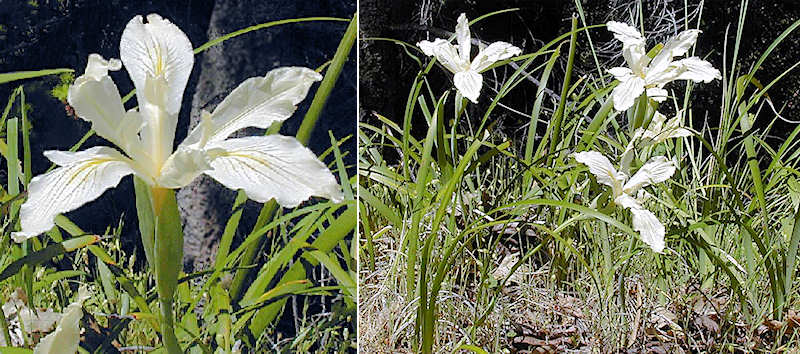Wild PCN iris - long tube group (5 species), spathes enclose ovary:
6. Purdy's iris - Iris purdyi

Photos: (L & R): Iris purdyi, Old Skaggs Spring Road, Sonoma County. Steve Ayala

Range: Northern California's western coastal ranges between Sonoma and Trinity counties, to about 3,000 feet elevation.
Original material: Ukiah, Mendocino County, California 1897
Key identifying features:
- Large, flattish flowers with broad, spreading petals and sepals.
- Stigma truncate or even bilobed (not triangular).
- Short, inflated, overlapping bract-like leaves enclose stem, only the tips free.
- Long, funnel-shaped floral tube, 1¼ to 2½ inches.
- Spathes very broad, enclose ovary and most of floral tube.
Flower color: White, cream or soft yellow, sometimes tinged purple, usually with prominent reddish-brown or purple veins on petals.
Habitat: Thick, humid leaf litter on the moderately shaded forest floor, surrounded by redwood, Douglas fir, tan oak, madrone, bay and other mixed evergreen trees.
Name: By Alice Eastwood, after Carl Purdy of Ukiah, a collector and nurseryman, who first called attention to it as a unique species.
Comments: The large, flattish ("starfish-like") flowers make Iris purdyi one of the more easily recognized of the Pacific Coast Iris. It is the only PCI with a truncate, non-triangular stigma, and appears less closely related to the other species of the long-tube group. Mature plants grow as individuals or in loose, sparse clumps.
In much of its range, where it has crossed with other wild iris, the hybrids often don't have the look of pure I. purdyi. The broad, flat flowers of plants in unmixed stands tend to be mostly white or cream color with pale or prominent reddish brown veins. Along the coast near Iris douglasiana, or inland near Iris macrosiphon, the veins are often purple and the petals may have a maroon, purple or lavender wash.
- Additional Photos:
- Lake Sonoma region, Sonoma County, California